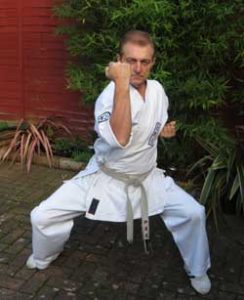Empi Shiru geto kata Seal the gates
Translation to the Empi form is ‘Seal the Gates’ this is the eight upper gates of the arm and the eight lower gates of the leg, sixteen in total. Seal the gates translation of Shiru Geto reflects its strategy, the art of planning and directing the specific purpose of the form. Concepts, principles and strategy is the result of good form training, whilst also developing the correct alignment and body control to functionalise the techniques inherent in the form.
The sequence to the form is as follows:
Section A is the upper body, direction (Hiji) elbow strikes with centre line covering (Chuosen)
and latching (Kake Uke). Performed in Sanshin Stance.
Section B is the knee (Hiza) and kicks (Keri). The knee and kicks are low line aimed at the opponent’s legs, mainly at the joints of the ankle knee and hip. The directions of these techniques are forward, back and forty five degree angle.
Shiru Geto, Sanshin, Tensho and Naihanchi blend the strategy of Shi Zen Do concepts as the very idea to seal, attack or strike through the gates of the opponents whilst guarding your own gates. Simultaneous, directional High, middle and low line attacks through the sixteen gate method using In Yo (Yin Yang) martial energy.
There are many applications to Empi, as this kata can be applied through boxing combinations, grappling techniques or as a supporting action to other kata. The sixteen gate method of training utilizes passing hands and sticky hands, whilst using the empi concepts of striking with this powerful part of the body. Another usage of the elbow is through a supporting role, the elbow can be used as a pinning or deflecting technique, almost like a second pair of hands to be used into the melee between to training partners. Knees are also employed at the same time, making good use of the straggly of striking high and low at the same time causing confusion within your training partners defence.
“The Art is the Flow the Flow being the Art”

